PESTS AND DISEASES OF FORESTRY IN NEW ZEALAND
Household borer, Anobium punctatum
Scion is the leading provider of forest-related knowledge in New Zealand
Formerly known as the Forest Research Institute, Scion has been a leader in research relating to forest health for over 50 years. The Rotorua-based Crown Research Institute continues to provide science that will protect all forests from damage caused by insect pests, pathogens and weeds. The information presented below arises from these research activities.
Forest and Timber Insects in New Zealand No. 32: House borer (sometimes called household borer).
Revised 2009
Revised 2001
Based on G.P. Hosking (1978)
Insect: Anobium punctatum (De Geer) (Coleoptera: Anobiidae)
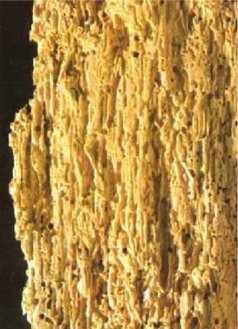
Fig 1 - House borer damage to rimu timber. (actual size).
Type of injury
The house borer is capable of causing severe damage to untreated dry timbers used in buildings and furniture. The larvae prefer to feed on the sapwood although some instances of damage to heartwood have been recorded. In the forest the insect breeds in dead parts of trees and in logs.
The initially distinct network of larval tunnels within the wood coalesces as the infestation progresses, and the wood structure is eventually destroyed (Fig. 1). The loosely packed bore dust has a gritty feel when rubbed between the fingers. It may be seen dribbling from the small (1-2 mm in diameter) round exit holes, having been dislodged by the emerging beetles, by parasites of the insect, or by simple vibration.
Hosts
A wide range of both native and exotic hardwoods and softwoods are recorded as hosts. Three commonly attacked species are Dacrycarpus dacrydioides (kahikatea), because of its superior nutritional properties, Dacrydium cupressinum (rimu), and Pinus radiata (radiata pine) owing to their extensive availability. Pseudotsuga menziesii (Douglas fir) and Thuja plicata (western red cedar) building timbers suffer very little damage. Normally only the sapwood of host species is susceptible.
Distribution
This insect is found throughout temperate regions of the world, including New Zealand.
Economic importance
This borer is responsible for most of the insect damage found in structural and decorative timber in New Zealand. Infestations may occur in untreated timber used for almost any purpose including structural timbers, exterior cladding, joinery, furniture, and flooring. In mild infestations damage is superficial and is important only where finished surfaces are marred by the appearance of exit holes. However, repeated reinfestation may result in the complete failure of the attacked timbers.
Infestations were common in houses constructed of untreated wood, but the universal use of preservative treated timber has greatly reduced the incidence of this insect. High temperature kiln dried wood may be less susceptible to attack for a few years, but should not be regarded as an adequate substitute for preservative treated timber.
Description, life history, and habits
The beetles are 2.5 to 5 mm long and reddish to blackish brown. The body is basically cylindrical, the prothorax forming a deep hood which completely covers the head from above (Fig. 2). The slender antennae are about one-third as long as the body and the three terminal segments are slightly flattened. The upper surfaces of the body are clothed in short, fine, yellow hairs which on the elytra (wing cases) are between rows of well-defined punctures. Females are usually larger than males.
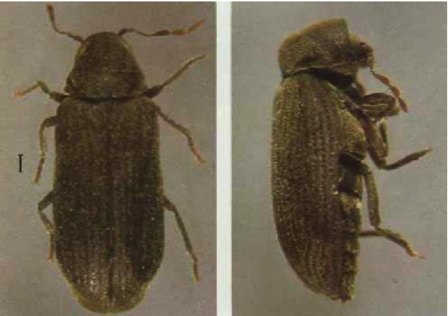
Fig. 2 - House borer adult, top view and side view. Note how the prothorax forms a hood over
the head. The line shows natural length.
The larva is a small (up to 7 mm long) creamy-white, C-shaped grub (Fig. 3). The head is yellow-brown with dark jaws. The thoracic segments are larger than the abdominal ones and have a distended appearance. Each thoracic segment is divided into a number of folds. The legs are short but well developed. The first eight abdominal segments are divided into a number of folds similar to those of the thorax. Bands of small spines are present on top of the rear thoracic segment and the first seven abdominal segments.
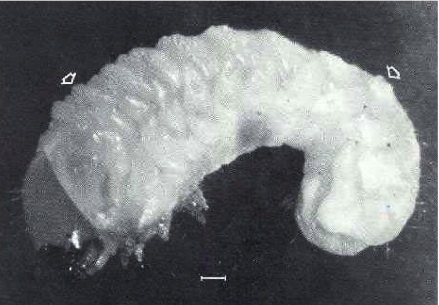
Fig. 3 - House borer larva. Segments between arrows have bands of small spines.
The line shows natural length.
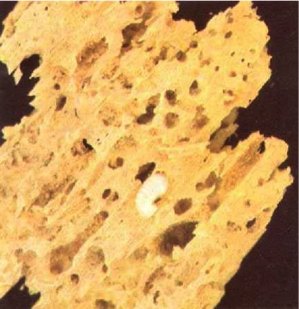
Fig. 4 - House borer larva and workings in rimu timber. Note the granular bore dust (x3).
The adult female lays small white eggs on rough-sawn surfaces, in cracks and crevices, or in old exit holes. They hatch in four to five weeks and the larvae bore down into the wood after first taking a bite from the upper part of the egg shell, upon which the female has deposited yeast cells. These symbiotic yeasts enable the insect to convert cellulose to protein, a process further assisted by the secretion of an enzyme which breaks down plant cell walls to simpler sugars.
The larvae feed within the wood (Fig. 4) and develop fastest at relative humidities over 70% and temperatures between 22oC and 23.5oC. The fully developed larvae excavate small chambers free from bore dust just below the surface of the wood, in which they pupate. The pupal period lasts from four to eight weeks, after which the adult bores to the outside making a circular exit hole (Fig. 5). Under normal conditions the time from egg to adult is three years in kahikatea sapwood and four years in the sapwood of rimu and radiata pine. The rate of development is influenced by temperature, moisture, and nutritional properties of the wood.
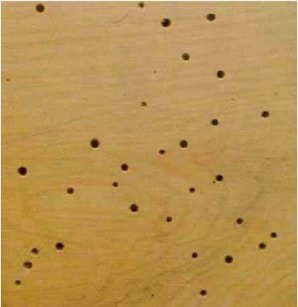
Fig. 5 - House borer emergence holes (actual size).
Adults may be found from November to January, and live for up to four weeks. They do not feed. In laboratory experiments some females have laid more than 100 eggs each, but in natural conditions considerably fewer may be produced.
Control
Detection of adults using pheromone traps, insecticide treatments and alternative treatments (heating, freezing, atmospheric gases) discussed in detail in Pinniger and Child (1996). Also literature review (Peters and Fitzgerald, 1996).
The most satisfactory treatment is the replacement of affected timbers with preservative treated wood. Where this is impractical, infestations may be destroyed by fumigation with methyl bromide or phosphine, but reinfestation can occur as soon as the gas has dissipated. Such fumigation can be done only by a licensed operator. Treatment with a contact insecticide with good residual activity is desirable after fumigation.
In New Zealand larvae of the house borer have been found to be parasitised by a braconid wasp Spathius exarator (L.), a pteromalid wasp Theocolax formiciformis (Westwood), and a mite Pyemotes ventricosus (Newport), but it is not known to what extent these limit numbers of their host.
Bibliography
Hickin, N.E. 1975: The insect factor in wood decay. 3rd ed. (rev.). Associated Business Programmes Ltd, London. 383 p.
Hosking, G.P. 1978: Anobium punctatum (De Geer) (Coleoptera: Anobiidae). House borer. New Zealand Forest Service, Forest and Timber Insects in New Zealand, No. 32.
Kelsey, J.M. 1946: Insects attacking milled timber, poles and posts in New Zealand. New Zealand Journal of Science and Technology 28(B): 65-100.
Kelsey, J.M. 1949: A note on the life-cycle of Anobium punctatum (De Geer). New Zealand Journal of Science and Technology 30(B): 211-214.
Kelsey, J.M.; Spiller, D. and Denne, R.W. 1945: Biology of Anobium punctatum. New Zealand Journal of Science and Technology 27(B): 59-68.
Peters, B.C. and Fitzgerald, C.J. 1996: Anobiid pests of timber in Queensland: a literature review. Australian Forestry 59 (3): 130-135.
Pinniger, D.B. and Child, R.E. 1996: Woodworm – a necessary case for treatment? New techniques for the detection and control of furniture beetle. Proceedings of the Second International Conference on Urban Pests: 353-359.
Waller, J.B. 1984: Household pests pp 205-220 in: Scott, R.R. (ed.) New Zealand pest and beneficial insects. Lincoln University College of Agriculture, Canterbury. 373 p.
This information is intended for general interest only. It is not intended to be a substitute for specific specialist advice on any matter and should not be relied on for that purpose. Scion will not be liable for any direct, indirect, incidental, special, consequential or exemplary damages, loss of profits, or any other intangible losses that result from using the information provided on this site.
(Scion is the trading name of the New Zealand Forest Research Institute Limited.)



